AMD Radeon HD 7990 Review: 7990 Gets Official
by Ryan Smith on April 24, 2013 12:01 AM EST- Posted in
- GPUs
- AMD
- Radeon
- Radeon HD 7000
- Tahiti
Compute
As always we'll start with our DirectCompute game example, Civilization V, which uses DirectCompute to decompress textures on the fly. Civ V includes a sub-benchmark that exclusively tests the speed of their texture decompression algorithm by repeatedly decompressing the textures required for one of the game’s leader scenes. While DirectCompute is used in many games, this is one of the only games with a benchmark that can isolate the use of DirectCompute and its resulting performance.
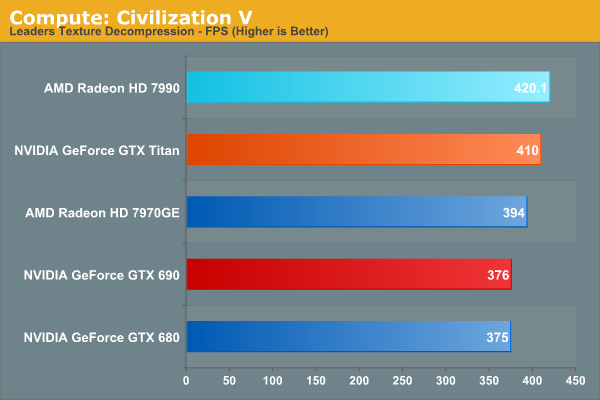
Civ V's texture compression routines are technically mutli-GPU capable, but multi-GPU scaling has never been particularly impressive here. So this test mostly reinforces what we already know about the Tahiti GPU being very capable in most DirectCompute workloads.
Our next benchmark is LuxMark2.0, the official benchmark of SmallLuxGPU 2.0. SmallLuxGPU is an OpenCL accelerated ray tracer that is part of the larger LuxRender suite. Ray tracing has become a stronghold for GPUs in recent years as ray tracing maps well to GPU pipelines, allowing artists to render scenes much more quickly than with CPUs alone.
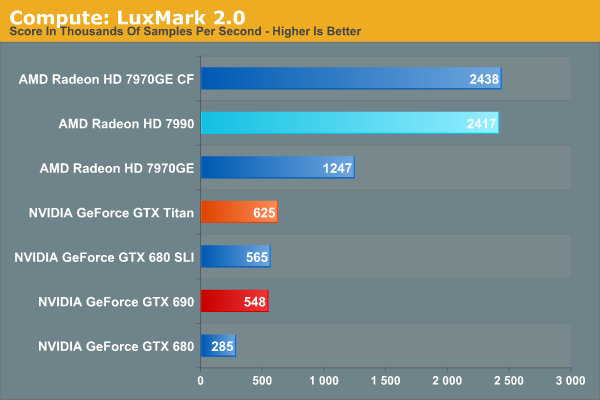
The 7990 isn’t billed as a compute product, but that doesn’t mean it’s at all weak at compute. On the contrary, as LuxMark doesn’t hit the ROPs hard the 7990 has no trouble staying under its 375W target, allowing it to sustain 1000MHz indefinitely. As a result the 7990 takes AMD’s compute advantage and runs with it. The 7990 is a bit more 2x the cost of a 680, but it’s 8.5x faster. Even against GTX Titan the difference is just short of 4x; NVIDIA simply doesn’t do well in our OpenCL tests.
Our 3rd benchmark set comes from CLBenchmark 1.1. CLBenchmark contains a number of subtests; we’re focusing on the most practical of them, the computer vision test and the fluid simulation test. The former being a useful proxy for computer imaging tasks where systems are required to parse images and identify features (e.g. humans), while fluid simulations are common in professional graphics work and games alike.
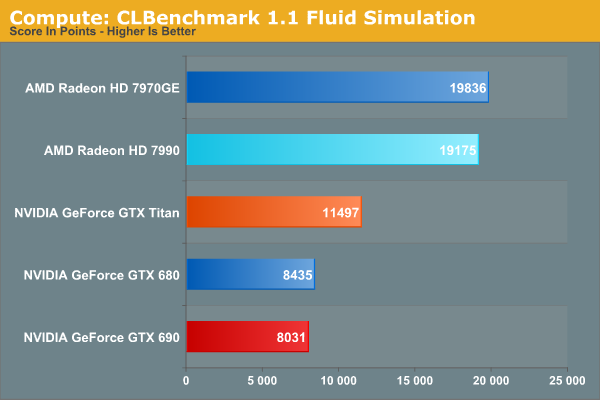
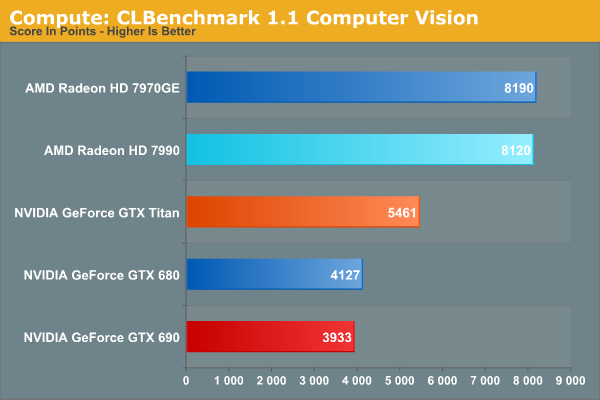
These two CLBenchmark sub-tests aren’t multi-GPU capable, so the performance of the 7990 is essentially dictated by its first GPU. All that means however is that the 7990 is once again at the top of the charts, well ahead of NVIIDA’s other cards and beating Titan by 50%-100%. At the same time this is a good reminder that not every compute task scales well across multiple GPUs, which is why single-GPU products still have a strong place in the GPU compute world.
Moving on, our 4th compute benchmark is FAHBench, the official Folding @ Home benchmark. Folding @ Home is the popular Stanford-backed research and distributed computing initiative that has work distributed to millions of volunteer computers over the internet, each of which is responsible for a tiny slice of a protein folding simulation. FAHBench can test both single precision and double precision floating point performance, with single precision being the most useful metric for most consumer cards due to their low double precision performance. Each precision has two modes, explicit and implicit, the difference being whether water atoms are included in the simulation, which adds quite a bit of work and overhead. This is another OpenCL test, as Folding @ Home is moving exclusively OpenCL this year with FAHCore 17.
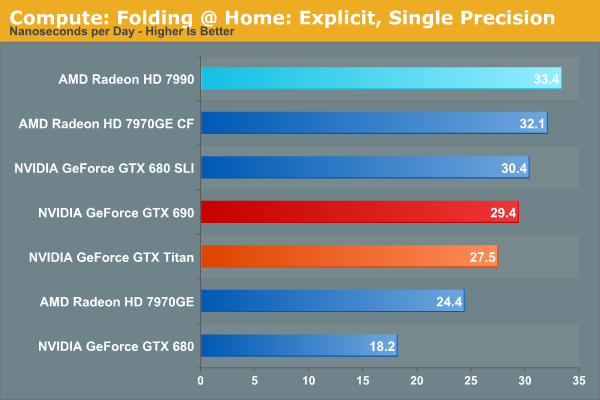
Only FAHBench’s explicit mode is multi-GPU capable, and even then the scaling to multiple GPUs isn’t great. Still, it’s enough to help the 7990 take the top spot on this benchmark, even with NVIDIA’s latest drivers slightly closing the gap. What’s particularly interesting here though is that the 7990 is faster than the 7970GE CF, and that’s not a fluke in our results. The 7990 should by all means be at least a bit slower, and more if throttling kicks in. It looks like we’re seeing one of those rare cases where the GPUs are benefitting from the presence of the PLX bridge, as going through the relatively close-by bridge is faster than in a two-card setup where the GPUs would have to communicate through the CPU/Northbridge. However this is the only time we see such an advantage; in most other compute scenarios – let alone gaming – the PLX bridge won’t have any kind of notable impact.
Wrapping things up, our final compute benchmark is an in-house project developed by our very own Dr. Ian Cutress. SystemCompute is our first C++ AMP benchmark, utilizing Microsoft’s simple C++ extensions to allow the easy use of GPU computing in C++ programs. SystemCompute in turn is a collection of benchmarks for several different fundamental compute algorithms, as described in this previous article, with the final score represented in points. DirectCompute is the compute backend for C++ AMP on Windows, so this forms our other DirectCompute test.
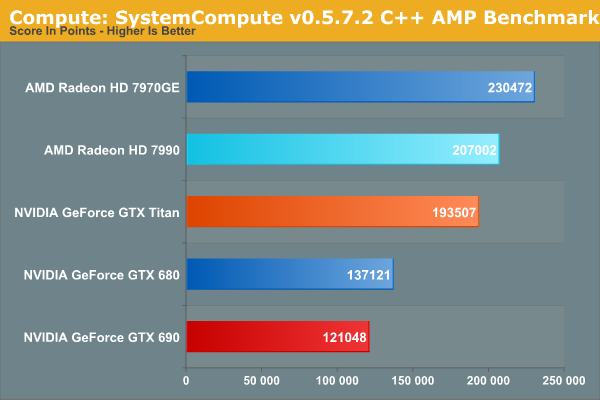
SystemCompute isn’t multi-GPU capable, so once again we’re leaning on the 7990’s first GPU. To that end we find the 7990 in second place, but we also see the 7790 clearly trailing the 7970GE by more than we’ve seen in our other compute benchmarks. SystemCompute does do a lot of I/O, so if FAHBench is the ideal case for showcasing the benefits of the PLX bridge in GPU to GPU I/O, then SystemCompute is good case for showcasing the drawbacks of the PLX bridge, mainly the higher I/O latency. It’s not enough to cripple the 7990 – it’s faster than the GTX Titan even here – but it does cost the 7990 some performance.










91 Comments
View All Comments
Torrijos - Wednesday, April 24, 2013 - link
I guess you didn't understand me!My point is, no matter the excuse, if FCAT results weren't available to provide the potential consumers with the proper information on what he would be purchasing, the article shouldn't have been published.
They say the results are coming in a week...
Good! Let's wait a week.
Instead we get superlatives and plots about how great the card is doing, except that some other site (PCPer) had the time to present FCAT result and as of right now you would be trowing money out the window.
Good news though that same site tests the experimental drivers and show that AMD might be on a path to a solution, BUT no release date for that driver, so NO IDEA WHEN this 1k$ card would FINALLY be useful!
There is no excuse, if you have an ounce of scientific integrity, to present a paper/article without the proper data. That is embarrassing!
rocky12345 - Wednesday, April 24, 2013 - link
What I find funny is that a year ago you would have taken these numbers & most likely ran to the store with cash in hand to be the first in line to buy one of these cards. But because someone somewhere was bored & decided that straight Frame rate numbers was so 90's & decided to make some crap software that breaks things down to each & every frame you now can not decide if a card is good or not withoout these fcat numbers. If any given card produces smooth frame rate in a game at the monitors res & refresh then it is a good card. But if all your looking at is unlocking the refresh & spending all of your time bench testing then enjoy your beloved fcat. myself I tend to enjoy actually playing the games I will let others spend their time worrying about the fcat numbers if that is all that is important to them.Like I said if a given card can hold its frames at my monitors refresh then that is all thats important.
rocky12345 - Thursday, April 25, 2013 - link
I may have been a bit harsh in my last post. I went to that site read the review on the 7990 & then read the fallow up review about the prototype 2 drivers http://www.pcper.com/reviews/Graphics-Cards/Frame-... and AMD is indeed on the right path on sorting this out.I myself have never noticed these issues in my games because I am normally to involved in the action or story to notice the tiny glitches or runt frames as everyone is pointing out.
Klimax - Wednesday, April 24, 2013 - link
I'd like to ask what mode was Titan in for compute tests? Was it Single or double precision. (Can't test it yet unfortunately as I do have Titan myself)Ryan Smith - Wednesday, April 24, 2013 - link
SP mode for everything except FAH's double precision tests.yannigr - Wednesday, April 24, 2013 - link
No comment about the game bundle in the conclusion? 8(not one or two) NEW and FREE and TOP(most of them) games don't count when deciding about a $999 card? I don't think that everyone is downloading games from torrents.A5 - Wednesday, April 24, 2013 - link
There's a comment earlier. It's not really worth mentioning in the conclusion.R0H1T - Wednesday, April 24, 2013 - link
I'd think that over the lifetime of this card one would/could easily recuperate his/her expenditure with bitcoins & as such given the possible improvements in performance especially with future driver updates this dual GPU card is a much better deal over the titan or GTX 690, again over a long(er) period of time not counting the short term drawbacks !A5 - Wednesday, April 24, 2013 - link
Don't peg your cost/benefit analysis to Bitcoins. That's dumb.R0H1T - Wednesday, April 24, 2013 - link
Umm did you miss the part where the game bundle is worth ~350 $ in itself ? The bitcoin mining is an added advantage & unless you think its asinine for one to go down that route, FYI the bundled games are also resold, it's disingenuous for anyone to suggest that mining bitcoin isn't worth it !